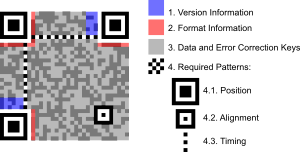A QR code (short for Quick Response) is a specific matrix barcode (or two-dimensional code), readable by dedicated QR barcode readers and camera phones. The code consists of black modules arranged in a square pattern on a white background. The information encoded can be text, URL or other data.
Common in Japan, where it was created by Toyota subsidiary Denso-Wave in 1994, the QR code is one of the most popular types of two-dimensional barcodes. QR is the abbreviation for Quick Response, as the creator intended the code to allow its contents to be decoded at high speed.[1]
The technology has seen a large uptake in Japan and South Korea. However, in the west there has been a considerably slower adoption of QR Codes.[2]
[edit] Overview
Although initially used for tracking parts in vehicle manufacturing, QR codes are now used in a much broader context, including both commercial tracking applications and convenience-oriented applications aimed at mobile phone users (known as mobile tagging). QR codes can be used to display text to the user, to add a vCard contact to the user's device, to open a URI or to compose an email or text message. Users can also generate and print their own QR codes for others to scan and use by visiting one of several free QR code generating sites. Frank C. Hudetz, a US Marketing Services Professional, falsely claims to have invented the QR Code[3] while claiming to be the inventor of mapping UPC codes to a URL.[4] Many dispute the "false invention" claims made by Frank C. Hudetz, including the EFF (Electronic Frontier Foundation) and members of the public domain[5][6].
QR codes storing addresses and URLs may appear in magazines, on signs, buses, business cards, or on just about any object about which users might need information. Users with a camera phone equipped with the correct reader application can scan the image of the QR Code to display text, contact information, connect to a wireless network, or open a web page in the phone's browser. This act of linking from physical world objects is known as a hardlink or physical world hyperlinks.
Google's mobile Android operating system supports QR codes by natively including the barcode scanner (ZXing) on some models, and the browser supports URI redirection, which allows QR Codes to send metadata to existing applications on the device. Nokia's Symbian operating system is also provided with a barcode scanner, which is able to read QR codes,[7] while mbarcode [8] is a QR code reader for the Maemo operating system. In the Apple iOS, a QR code reader is not natively included, but over 50 free Apps are available with reader and metadata browser URI redirection capability. HP/Palm's webOS operating system also does not have a native QR code reader, but a reader app named QR deCODEr is available[9]


Comments(1)